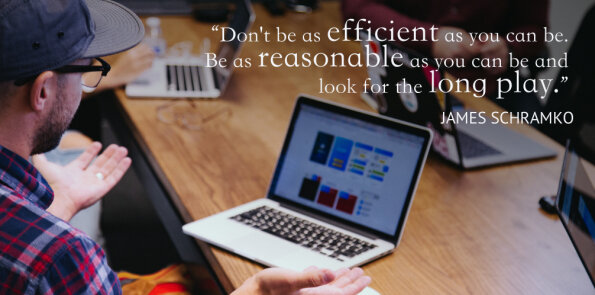Podcast: Download (Duration: 59:44 — 55.5MB)
Get Notified Of Future Episodes Apple Podcasts | Spotify | Amazon Music | Android | Blubrry | Gaana | TuneIn | Deezer | Anghami | RSS | More
James’s team of Filipino VAs have been with him for over ten years. That makes him a kind of authority on what it is to hire Filipinos and work with them, something he’s spoken on before. In this episode, he addresses questions people have on hiring and managing Philippine virtual assistants.
James discusses what kind of tasks you can count on your VA to perform, and the employee skills training they may need.
He takes on the topic of critical thinking, and the cultural differences between a western hire and a virtual assistant from the Philippines.
James answers the questions of, how do you pay employees from the Philippines? What are the do-not-hire warning signs? And much more…
Table of contents
1. High level, high-trust tasks
2. Virtual assistant versus executive assistant
3. How much overseeing will you do?
4. Weather and infrastructure
5. How good are they at critical thinking?
6. Finding particular experience
7. Red flags to watch out for
8. The things you wouldn’t hire for
9. Biggest cultural difference from the west
10. A knack for service
11. How to be ready for your team
12. When you have to let someone go…
13. How to manage expectations
14. Guarding against data breach
15. How to pay your team legally
16. For shorter onboarding, do this
17. How much bandwidth can you expect?
18. The matter of holidays
19. Don’t expect it all of one person
20. Sustainability over efficiency
21. The value of learning new skills
22. How competitive is the market?
23. Can you get around the exchange rate?
24. How to avoid churn
25. Qualifying candidates for skill
26. How high do pay rates run?
27. Why not just hire from the West?
28. Integrating Filipinos with Westerners
29. Getting better applicants for the role
High-level, high-trust tasks
Q: How high-level tasks can you actually trust them with?
A: In James’s experience, given appropriate time and training, you can trust your Philippine team with a very high level of task. His own team do bookkeeping, website upkeep and development, and emails, which he considers high-trust activities.
Beside coming from a religious and family-oriented culture, James’s team have his business culture instilled in them: communication, integrity, Ninja good. So over time, he’s been able to trust them with very sensitive details – logins, passwords, purchasing things with credit cards, etc.
Naturally, you wouldn’t give that level of trust to someone new, but give them time to earn your confidence.
Virtual assistant versus executive assistant
Q: How do you define a virtual assistant versus an executive assistant?
A: A virtual assistant would simply be someone, not in your physical presence, who helps you with things you need done.
When James had 65 people on his payroll, he had teams, and team leaders who reported to him. And one of his VAs was effectively his executive assistant, helping him interface with the team leaders, manage travel, respond to inquiries and the like.
Whether you require just one and/or the other will depend on the needs and structure of your business.
How much overseeing will you do?
Q: How much oversight do you expect of a Filipino virtual assistant versus a US versus a European virtual assistant?
A: James would say it’s probably the same. He thinks oversight will be a factor of:
– What expectations have been set from you
– How clearly your team member understands the expectations
– If those expectations are being met
James’s team post a little note of what they’re up to in Slack, first thing at the start of the work day. And in the evening they post another note of what they’ve done.
They also meet with James once a week via a Slack huddle, to align on the overall health of the business, on what needs to be achieved, and to voice challenges or concerns.
James does not micromanage. He thinks that’s crazy to hire people and then get in their face. If you’re a micromanager, you might as well do things yourself.
Weather and infrastructure
Q: What are some things to take into consideration with weather and infrastructure risks?
A: This really depends on where your team is. It’s very general to say your team member is in the Philippines – whereabouts in the Philippines?
Certain regions are more sensitive to weather, and to electricity shutdowns. Around Manila, there’s more availability of power and infrastructure, and in case of an outage, often team members can go to the mall for electricity and internet access.
Then, too, it’s easy now in that area to get multiple internet providers, and portable wifi for backup.
James has a team member in a regional area who does a lot of work at night, when power is more stable. It hasn’t been an issue in the 10 years she’s been with him.
How good are they at critical thinking?
Q: Is it true about the stereotype, Filipino workers don’t have good critical thinking skills?
A: Filipinos are normal people, says James.
You might think, because they go through school and university, and often enter call centers, that they’re trained to be told what to do. That is true. They’re very, very good at following instructions.
What you can do, however, is put them in an environment where they are able to think for themselves, and are required to think for themselves. James has done that for his team, and made it safe for them to make mistakes, as long as they do it in the best interests of the clients and of the business.
James’s team are great thinkers, he says, who often come to him with suggestions. He thinks Filipinos in general are great critical thinkers when you set up the environment, and you have a program or process for developing them.
Finding particular experience
Q: How does one find a virtual assistant who has particular industry experience, i.e. legal or contract drafting skills?
A: James’s short answer is, he hasn’t really focused on that. There are marketplaces, jobs boards, and referrals, all of which he hasn’t done, and so isn’t qualified to speak to.
He does think that people with a particular expertise can often command high rates, and may be taking on multiple employers.
James’s team come largely from call centers, and were happy to work from home and learn the necessary skills. What that meant over the long term was loyalty and a great deal of job satisfaction.
When James does need specialized skills like high-level design or paid traffic, he gets a Western supplier and lets them collaborate with his team in Slack. That, he’s found, is a great hybrid model.
Red flags to watch out for
Q: What are the red-flag, do-not-hire warning signs?
A: If someone doesn’t show up for their appointment, or are late, that would probably be a red flag for James, especially if they didn’t communicate it in advance.
If you find that the basic level of English or comprehension is not that great, or if the equipment is not decent, those would be potential red flags.
Another is if they want you to pay to someone else’s name. That might mean issues with them being able to have a bank account.
It would be a red flag if they don’t show up often after you hire them, or if they’re sick very quickly, or have got a family member always sick. They just might not like working for you.
The things you wouldn’t hire for
Q: What tasks wouldn’t you generally hire for?
A: Anything super specialized, James generally seeks outside his team. Paid ads, graphic design, SEO strategy, copywriting, apps, etc.
Filipino VAs are very good at support and content wrangling – editing and putting words on websites, editing video and audio, building sites. If you use a no-code platform like Kleq, that’s actually amazingly easy for a VA to learn, But James has team members who have learned coding since he hired them.
Philippine VAs can send out emails, do bookkeeping, manage your scheduler, reply to people in your email, manage your inbox if you want. A lot of the general stuff that shouldn’t occupy a business owner’s time.
Biggest cultural difference from the west
Q: Biggest cultural difference between a Philippines VA and hiring someone in Australia?
A: The most important, James thinks, is that an Australian or American hire is more likely to poach your business. He’s seen it hundreds of times.
They get to know your business model and how you profit. They get to know your customers, and eventually deal directly with them. Then they take your team and your business model and start competing with you.
This is something James has not seen in the Philippines. What he has seen is support and loyalty, which he loves.
A knack for service
Q: How is it the Filipino assistants are the best in terms of communication responsiveness, attentiveness and agreeableness?
A: That’s a lovely thing to say, says James. And it’s because they’re a service-based culture; their biggest export is labor.
If you go into hospitals anywhere in the world, if you go on a cruise ship or into hotels, they all hire Filipino workers. Filipinos are very hospitality and service-oriented, because they have family values, and are raised to be polite.
That sounds like a generalization, but in James’s own experience they’re very friendly, nice people who are willing to serve and to please.
How to be ready for your team
Q: How do you ensure that your business is ready for them, i.e. systems, processes, communication, etc. to understand the difference in the culture to make the experience amazing?
A: James likes this question. It shows empathy and awareness.
You do need to be ready for your team. You can’t just hire someone and then put them to the side, give them no training, and a month or two later decide you can’t afford them anymore, and get rid of them.
These are people, they’re not cogs in a machine. So think about it from your point of view – when you joined a business or started a job, if you’ve ever had a job, what did you want to happen?
When you bring them in, give them a walkthrough. Tell them about your business. Why is the business here? What do you actually do? Who do you serve? What are you hoping to achieve from this new hire? And in terms of systems, you can build systems together.
Share your standard operating procedures. And as you teach your hire things, let them document so they can do it from then on. Or make them a Loom video, or give them a procedures manual, if you’ve already got one.
Better yet, give them a buddy, someone who went through the exact same role, who’ll show them the ropes.
And then check in with them very, very often.
When you have to let someone go…
Q: How to let go of a VA without feeling bad?
A: When people leave, says James, it might be your fault. You could be a poor leader or manager, or your company might be toxic, or they might have had a bad experience with onboarding – it could be that.
Or it could be legit, they’re just not performing; they didn’t get their expectations met, they’re not following the training. Or you discover something terrible, and they have to go.
Generally, the situation is created by the person, by their performance. And James was taught early on that you’re looking at the behavior of the person, not the person themself – so address the behaviors.
You can say, Look, your performance, the way that you have acted in this role, is not meeting the standard that we set out and talked about, that we provided training on, that we have had revisions on. We’re at a point now where it’s not sustainable.
We’ll give you appropriate notice, and I’m sorry that it didn’t work out. But you’re free now to find your dream role somewhere else, just not here.
It’s never good, says James – it doesn’t feel good as a human.
In most of the cases, it’s where the team member hasn’t performed, so you can feel better about it because if they had performed, they’d still be there. So they made the choice to leave, not you; all you’re doing is calling it what it is.
If the person is great and you can no longer afford them, a good option is to find them a new home. If they came from James’s recruitment agency, for instance, send them back – they’ll get a job straight away.
How to manage expectations
Q: How do you manage expectations with a VA?
A: Talk to them, document it, have a list of expectations – here’s the expectations we have for your role in the business. And these are the expectations you can have from us.
One that’s important, stresses James, is, you need to pay people on time or early every time. He’s paid his team three or four days early, every single pay, which is twice per month, and he pays them in their own currency in pesos.
Guarding against data breach
Q: A telecommunications provider, a healthcare provider, they’ve had big data breaches and subsequent ramifications, security and data protection measures, what can you do?
A: James would recommend, as he has with his own team, to put on two-factor authentication.
He has no fears any of his own team members would hack the business. But if they should get hacked, they have two-factor authentication in place.
They also use a password management tool, not because James doesn’t trust them, but because it’s much easier to have one password management tool that they can all just click on. And if someone leaves, as a matter of process, they update the passwords.
They also do little things, like when he travels, James uses proxy servers, VPNs, etc. His team uses them a lot, because they might want to simulate that they’re in Australia, and not get locked out of some of the software tools they use.
And of course, build trust over time, so that you know that you can trust your people.
How to pay your team legally
Q: What’s the correct way to pay them legally?
A: The rules are a bit loose on this. If you’re in a country like Australia, or the UK, or America, Canada, etc., generally, your team in the Philippines will probably be viewed as an external contractor, basically a foreign contractor.
James’s own opinion on this – and he’s not a taxation specialist or a lawyer, so this is not advice – is they don’t fall within the Australian situation of payroll tax, superannuation, and the like; you’re making a payment to a contractor overseas, and they deal with their own tax and retirement, etc., and health funds. But James pays health funds for his team, anyway.
It’s up to you to set a framework. There’s lots of ways you can pay your team – you can use Wise; you could do a bank transfer; James still uses PayPal, just because he collects a lot of money in Paypal.
James’s team all have PayPal, and he likes to pay his team in their own currency, twice per month, every month.
For shorter onboarding, do this
Q: Best way to go about reducing training and onboarding time with better hiring?
A: Do a test before you a Filipino VA, says James. Pay them for a test task, that’s totally acceptable.
If you pay them for tests, you’ll have a pretty good indication as to their ability, and what you’ve got to work with.
When they come on board, give them procedures or give them a person to take them through the training, or do it yourself.
Don’t overwhelm them, of course – give them realistic stepping stones to move forward through the business. James has found within two weeks someone in his business is doing a pretty reasonable job, with no prior experience in the industry whatsoever.
How much bandwidth can you expect?
Q: What are the limitations and bandwidth, typically, for a Filipino VA, for example, social media, if we supply the content, etc?
A: The main limitations are their natural abilities – things like design and the like, there’ll be limitations. There’ll be limitations in terms of how safety-focused they are versus how much risk they’re willing to take, and that’s mostly a factor of you, the employer.
There’ll be limitations in terms of time or availability, in case they get rolling brownouts or internet issues, or if they’re weather-affected, or if they have a family illness, these are things to take into account.
Some of those things are not within your control. But a lot of things are, like what region do you hire from? Are you hiring close to the city?
What experience did this person have in their previous role – were they a team leader of a call center team, for example? Almost everyone in James’s business worked in a call center, and many were leaders, with people under them, so they already demonstrated fantastic ability, and that’s why they’re so good at support and critical thinking.
On the other hand, all of James’s media, his podcasts, his videos, everything you see him publish comes from his team. And they had no experience when they started with him.
So you can train them over time, and the best way to train someone is to show them an A paper. James, for instance, might show his team a video and say, This video is amazing; I want videos like this.
You’ll be amazed what your VA can do over time. Unbelievable. As long as you train them, show them good examples, and give them time, and hire the right people, James believes you can take that all in house.
The matter of holidays
James thinks this is important – Filipinos have a very family-based culture, with a lot of holidays. And they even make them up as they go.
There’s a website you can go to that lists all Philippines’s official holidays.
James has found it much easier to just say, Take all your Philippine holidays off, be with your family, have a great life. He doesn’t mind, because they’re set up to cater for support on an ongoing basis, with people taking turns on a roster.
Filipino VAs will observe other holidays, however, if you need them to, and they can work different time zones if necessary. Often they’ve worked night shift before and would much rather do it from home.
Don’t expect it all of one person
Now when you hear about VAs editing videos, sending out emails, posting socials, and managing comments, bear in mind, that’s not one person’s role.
Some people imagine one VA taking everything off their plate and doing it all on an hourly rate. Forget that, says James – hire a couple of people, and hire them for 40 hours a week, full time.
It might cost you $1,500 or $2,000 a month to have two to three incredible team workers in your business full time, who are dedicated to your success. That’s where the magic happens.
Sustainability over efficiency
James has read a comment: the more efficient I can make it, the better.
Wrong, he says. Don’t make it efficient; don’t over-optimize your team and burn them out.
The fastest Olympic runner will last 20 minutes at full speed. James’s team have stayed with him for 10 to 12 years, because he gives them time off – they’ll do one major project here and there, and then have a rest.
He pays around $100,000, $150,000 a year in wages. If he can make a million or two million a year, and pay $150,000 to have everything in his business done for him that he doesn’t want to do, that is a good deal.
So don’t be as efficient as you can be. Be as reasonable as you can be and look for the long play.
The value of learning new skills
Q: I’d like to help them grow their skill and be able to utilize them for different tasks. If I set aside a portion of the week for just learning new skills, watching videos, tutorials, would that be something they would find valuable?
A: Yes, they would – James tells his team, go through the training courses, watch videos, learn stuff, play with new software, whatever. Do whatever it takes for you to be amazing in your role and to enjoy yourself and have a great life within our business, and they do.
How competitive is the market?
Q: I’d love to know more about how it’s evolved. Is it competitive to get good VAs? And wouldn’t it be great to know what they’re looking for these days too? What can help you retain the great ones?
A: That mindset will make you successful as a hirer, says James.
Yes, it’s more competitive than when he started hiring VAs. That’s why he and his wife created an agency, VisionFind.com, because the agencies that they knew of sucked, requiring numerous applications and charging a fortune.
At VisionFind, they ask a one-time recruitment fee. The team member they find works for you, and you pay them directly, and the recruiter butts out of it.
It’s competitive on jobs boards – there, you’re vying with numerous recruiters. If you want access to candidates no one else knows of, who have been expertly screened for English, equipment and ability, that’s the advantage VisionFind offers.
And yes, rates have gone up, but the market is huge and the investment is worth it.
Can you get around the exchange rate?
Q: What’s the best way to organize payments without getting screwed on the exchange rate?
A: James doesn’t mind paying the exchange rate. What’s more important to him is his team can bank on their specific agreed amount in pesos, twice per month, without being currency traders.
Don’t be selfish about this, he urges. It’s a cost of doing business; he’d rather his team members not worry about the exchange rate, and just focus on being awesome at their jobs.
How to avoid churn
Q: How have you been combating churn attrition rate when the average stay of a Philippine employee is between one to one and a half years before they move on?
A: You’re doing it wrong, says James. Simple as that. It hasn’t happened to him.
If that’s happening, you’re getting the wrong people from the wrong place, or you’re just not an employer of choice.
James knows people who have had Philippine VAs six, seven, eight, 10, 12, 15 years. They will stay, if the place is good.
Qualifying candidates for skill
Q: What is the best way to qualify a VA for any given skill? Anything from bookkeeping to QuickBooks, extracting videos, etc?
A: You can pay them to do tasks. You can ask them for their portfolio of what they’ve worked on before.
And be open to the fact that some of these candidates won’t have experience and need training.
James’s team member knew nothing about Xero, and they’re able to do his bookkeeping every day.
There’s all sorts of training. You can use Loom. Even Slack these days has got huddles, you can talk to your team member in real time and take them through stuff together.
James likes collaborating with his team occasionally. When they migrated his website recently, he actually got on a huddle with his team member, opened up a Google Doc, and worked on it together – it was fun.
How high do pay rates run?
Q: Love to know the pay rates for particular roles and experience. This one concerns me. I’ve had some ask for Aussie salaries, okay?
A: James has checked with his team on this, and it’s false news. The pay rates of juniors run to 26,000 pesos per month, to seniors, middle of the road, 35,000, 45,000; very, very good, 50,000, 60,000.
Someone making 100,000 pesos per month, is probably CEO of a call center with 300 reports for a big American company – very westernized and savvy and extraordinarily experienced. James has not hired that type of person, or known many people who do.
Why not just hire from the West?
Q: Why not just hire more Americans and make less profit? America first, especially when you already make a great profit.
A: You do you, says James.
He hired an American for his first support role – the guy was okay until he wasn’t. James’s Filipino team took over and were amazing.
When he hired a Western website developer, the price kept going up, and the sites kept taking longer. James’s Philippines team did the job much quicker and cheaper.
The Western supplier, unfortunately, upset at losing the work, then tried to take James’s business by selling directly to his customers.
So James doesn’t see the point of making less profit when he’s got a good situation.
Integrating Filipinos with Westerners
Q: What are the best ways to integrate a Philippines-based assistant employee with an existing UK?
A: James likes the hybrid model. He’s advised clients, when their Western team member is getting stretched, to tell them they’re getting an assistant.
They’re usually thrilled, and don’t really mind as long as whoever’s working with them is polite and easy to communicate with, and delivers on their promises, and sets clear expectations.
James also highly recommends meeting your team members. If you go to the Philippines and meet your team, you’ll increase your productivity and enhance the relationship by multiples.
James is friends with his team. They understand each other from doing tons of activities together, from pistol shooting, to surfing, to restaurants, to traveling in vans to scenic locations.
They’re great people, says James, and he wants them to have a fantastic life, as he does.
Getting better applicants for the role
Q: How can one get better applicants and follow your instructions not to send canned messages?
A: Just get out of the rat race, James suggests. Use a company like VisionFind.com, and have them screen your candidates for you.
They’ll arrange an interview with your candidate, and you can do some kind of a paid test task.
And you’re not competing with anyone else – you’ve got the exclusive on the candidate while they’re with you, as long as you’re responsive. If you don’t respond to VisonFind for a week or two, they’ll probably send them to someone else, but that’s how it works.
The overarching message James wants to leave is that your team members in the Philippines are people. They breathe oxygen, have blood in their veins, eat food, watch movies, play games, enjoy their work; they’re not mud hut villagers running around in grass skirts.
They’re just normal people, and you can have the best relationship. So many companies have teams in the Philippines, you might as well join their ranks.
Every question James has answered in this episode is a question that was put to him on a Facebook post.
Access a wealth of business resources and support inside the James Schramko community
Liked the show? Leave us a review on iTunes













Leave a Reply